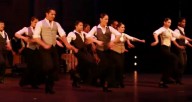It is a reasonable expectation that an evening spent with Ensemble Espanol Spanish Dance Theater will be one of awe-inspiring, passionate and energetic Spanish dancing, and the 43rd annual American Spanish Dance & Music Festival’s crowning event, “Flamenco Passion,” is no exception.
This year’s “Flamenco Passion,” which concluded Sunday at the North Shore Center for the Performing Arts, was particularly poignant. After appearances at the Spring to Dance Festival in St. Louis and as part of the Stomping Grounds Festival, “Flamenco Passion” is the first full weekend of mainstage performances for Ensemble Espanol since the death of their founder, Dame Libby Komaiko in February.
And much of the first half of the evening was a reprise of Komaiko’s April memorial concert at Northeastern Illinois University, interspersing video footage of her performing with various selections of classic repertoire. Saturday’s lineup included “Zapateado” (1976), a succinct, acapella, full company dance of the vaqueros, and “Ecos De Espana” (1983). The latter is a wide-ranging, two-part work beginning with a dramatic Flamenco quintet. This section is inspired by a series of grotesque Francisco de Goya paintings, set to the fourth (and perhaps most recognizable) movement of Nikolai Rimsky-Korsakov’s “Capriccio Espagnol.” The mood shifts abruptly into an effervescent, celebratory folk dance in the last section of “Ecos.” “Capriccio’s” fifth and final movement, “Fandango Asturiano,” brings pure joy, trading bravura for boisterous buoyancy, and long, ruffled trains for petticoats, pantaloons and castanets. “Ecos De Espana” showcases the classical styles umbrellaed under Spanish dance, and this company’s excellence in executing them all.
More than 35 years after Komaiko choreographed “Ecos De Espana,” Ensemble Espanol is committed not just to the preservation of its founder’s works. Evolution is a central tenet of the mission, pioneering new hybrid forms, pushing the boundaries and upping the stakes for Spanish concert dance. A world premiere for five couples, “Pasion Oculta,” by artistic director Irma Suarez Ruiz might be a perfect example of how EE continually ups the ante each year.
Understated costumes – all black for the men and gorgeous cerulean gowns for the women – are illuminated by stunning, appropriately ostentatious lighting from Dustin Derry. Stenciled circles follow each couple around the stage, supplemented by one of the most effective uses of back light I’ve ever seen. It makes for high drama, copied in Ruiz’s extravagant choreography. The premise: in short, each man’s passionate love for his invisible partner brings her to life – they’re not actually invisible, but shrouded in veils at the beginning and end symbolizing an ethereal being. Heightening the drama, two pieces by Escala, an electronic string quartet, create a driving pulse for the stamping of heels and sharp snaps of the arms overhead. Inadvertently or not – it further hints at the plot with the use of “Palladio,” a piece of music forever engrained in my head as the De Beers “diamonds are forever” commercial.
Bookending “Pasion Oculta” are a pair of works by guest artist and choreographer Carlos Rodriguez. There's an electrifying solo called “Seda,” in which Rodriguez performs with percussionist Pedro Medina. A group work, “La Piel Desnuda,” is a flamboyant and light-hearted delve into the Baroque period. Here, executive director Jorge Perez makes a cameo appearance, entering the house backed by a bright beam of light and fog, dressed in steam punk garb like he’d just gotten out from a time machine. He makes his way to the stage and wills the curtain to rise, revealing full-on Marie Antoinette stylings – wigs, bustles, knickers and ascots – the whole nine yards. It’s a look I honestly didn’t expect, even knowing beforehand that “La Piel Desnuda” was a foray into the Baroque. Rodriguez’s inquiry of the period and its similarities and differences between the rhythmic patterns and aesthetics of Spanish dance, as an academic exercise, is exceedingly interesting. And had the silliness of the whole thing been backed by a more serious investigation of Baroque dancing – first and foremost demarcated by turned out feet and stiff torsos (because, corsets) – I could have wholeheartedly bought into this piece.
Alas, it was an uncharacteristically sloppy execution, perhaps wholly due to this being unfamiliar territory for these dancers. But as the courtly scene dissolved into a dream-like sequence featuring not-oft-highlighted dancers Samantha Micklewright and Jonathan Pachecho in a lovely pas de deux, which led into a more comfortable Flamenco romp at the end, this almost always exceptional ensemble once again found itself on familiar footing.
Guest artist Jose Barrios, too, offered a group work and a solo, the latter an excerpt from his 2017 ballet “Reditum.” Barrios performed with musicians Javier Saume-Mazzei, Paco Fonta, Antonio Gabarri Jimenez and David Chiriboga; as the instrumentalists joined him one by one, Barrios danced lightning-fast footwork echoing the rhythms of the guitar and drums, stopping every so often to garner applause, from which he seemed to harness energy to go faster still. His festive “Triana,” for the full company ended the night, but not before the ravishing Carmela Greco offered a soulful solo inspired by the poetry by Federico Garcia Lorca, the Youth Company danced a charming Greco piece, and earlier, principal dancer Monica Saucedo performed a classy, understated solo dedicated to her mentor, Dame Libby.


